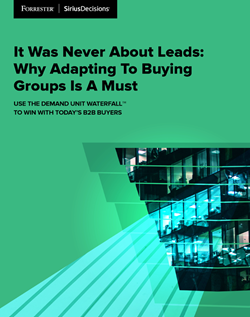B2B marketing has seen a dramatic change in the last decade, driven by radical advances in marketing technology and the emergence of new channels. Even if you acknowledge that change as fact, however, it’s easy to become cynical (as I have) when vendors and thought leaders are constantly proclaiming the “death” of the old ways. If we’re to believe the experts, the following is true:

* Email is dead.
* Cold-calling is dead.
* Content marketing is dead.
* The MQL is dead.
And so on. When in fact, none of these things is true. Change in marketing is an evolution, not a coup. Email, as one example, plays a very different (and less dominant) role in the marketing mix than it did only a few years ago, having migrated from acquisition to nurture and customer marketing. But there are still 5+ billion email accounts worldwide. Email is very much alive.
Indeed, those who announce that anything is “dead,” marketing-wise, typically have an agenda in mind, most often selling you a product or solution to facilitate whatever replaces the (allegedly) departed. When Account-Based Marketing (ABM) first arrived on the scene, vendors were quick to pronounce traditional, funnel-based marketing obsolete. Today, ABM is a very real and effective way of driving demand, but even its most fervent disciples would acknowledge that, at most companies, ABM co-exists with other strategies rather than having replaced them altogether.
One fixture of B2B marketing for more than a decade is the
lead funnel, brought to prominence by the analysts at SiriusDecisions (now part of
Forrester.) In the years since, the
authors of the original model (which SiriusDecisions calls the Demand Waterfall ) have
re-engineered its design
to reflect what they say is the reality of the B2B marketplace and how modern purchase
decisions get made. Even so, to their
credit (and possibly frustration), the lead-to-MQL funnel still has broad application,
and millions of B2B marketing dollars are budgeted, planned, and measured each
year using the original framework.
) have
re-engineered its design
to reflect what they say is the reality of the B2B marketplace and how modern purchase
decisions get made. Even so, to their
credit (and possibly frustration), the lead-to-MQL funnel still has broad application,
and millions of B2B marketing dollars are budgeted, planned, and measured each
year using the original framework.
Report: Why Demand Marketers Should Expand their Focus Beyond the Lead
Click To Tweet
Still, in their newest report: “It Was Never About Leads: Why Adapting to Buying Groups Is a Must,” the experts at SiriusDecisions make their most compelling case yet for why measuring leads, if not quite dead, may be less relevant than ever. Even cynics like me will find the argument convincing. For those demand marketers promoting complex solutions, with long sales cycles, into large organizations, this is a must read. The report’s key messages are these:
* Most complex B2B buying decisions are made by a group, not an individual
* Marketing and sales must adapt processes to attract, engage, and convert these buying groups
* Lead-centric processes are ill-equipped to properly market to a group-buying dynamic

The report goes on to
describe the evolution of the waterfall since 2006 to what it now calls the
Demand Unit Waterfall , a model that focuses on buying groups vs. individual
leads, recognizes multiple selling opportunities within accounts, and tracks
opportunities from target market (not just engagement) to close. Readers will also learn practical ways to
introduce, apply, and operationalize the new model, including how to leverage
the Opportunity Object within their existing CRM systems.
, a model that focuses on buying groups vs. individual
leads, recognizes multiple selling opportunities within accounts, and tracks
opportunities from target market (not just engagement) to close. Readers will also learn practical ways to
introduce, apply, and operationalize the new model, including how to leverage
the Opportunity Object within their existing CRM systems.
Any marketer (or sales leader) who has generated multiple leads within the same account only to realize, well downstream, that those “hand raises” were part of the same selling opportunity, or perhaps opportunities for different solutions, will see the wisdom of adapting lead management to the demand unit model. Last year, our firm used the Demand Unit Waterfall as the basis for creating the Opportunity-Based Marketing (OBM) Framework, a proprietary model that helps clients plan and execute ABM strategies, determine the appropriate channels and tactics for different stages in the buying cycle, and establish clear, consensus metrics for ABM success.
Indeed, the new Demand Unit Waterfall is a critical understanding for any company for whom ABM is a primary marketing strategy or significant investment. To be clear: the lead funnel isn’t dead, and a funnel-based strategy still has merit, especially for companies marketing to SMBs or selling less complex solutions. For everyone else – and, in particular, enterprise marketers and ABM devotees – a move to this newer approach is an evolution well-worth considering.
To download the SiriusDecisions report (free download, registration required), click here.
For a more detailed look at the OBM Framework, download the ebook: “A Pragmatic Guide to ABM Success.”
Photo by Drew Graham on Unsplash
The post Report: Why Demand Marketers Should Expand their Focus Beyond the Lead appeared first on The Point.


















